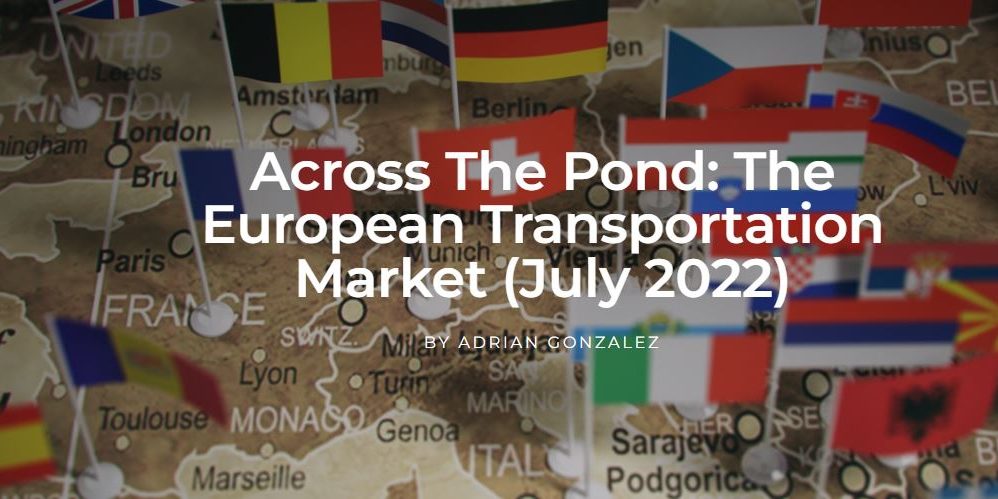You’ve probably heard the phrase, “May you live in interesting times.” It’s supposedly a Chinese curse, although there is no verified Chinese source for the phrase. Nonetheless, to live in interesting times, per the curse, is to live in times of trouble and uncertainty.
I think we can all agree that we have all been living in interesting times since 2020, starting with the COVID-19 pandemic, which is still with us, through the current Russia-Ukraine war.
The reality, however, is that uncertainty is not something new that we have to deal with. It has always existed and it is here to stay.
Of course, if you work in transportation, you already know this is true. It is a market that goes through cycles continuously, and there are many factors and variables that impact it, many of them outside our direct control.
One big factor is overall economic conditions, which are deteriorating at the moment. According to the World Bank’s latest Global Economic Prospects report published in June, “Global growth is expected to [decrease] from 5.7 percent in 2021 to 2.9 percent in 2022— significantly lower than 4.1 percent that was anticipated in January.”
The World Bank expects growth to hover around 2.9 percent over the next two years, as “the war in Ukraine disrupts activity, investment, and trade in the near term; pent-up demand fades; and fiscal and monetary policy accommodation is withdrawn.”
Looking at specific countries, the Bank of France now expects the country’s economy to grow 2.3% this year, down from its March forecast of 3.4%.
And as reported by Reuters on June 21, Germany’s BDI industry association cut its economic growth forecast for 2022 to 1.5%, down from the 3.5% it had forecasted in late February before the Russia-Ukraine war began.
To make matters worse, as reported by Reuters, “Euro zone inflation rose to a record high 8.1% in May, more than four times the European Central Bank’s target.” According to the article, “While a 39% rise in energy costs was the main driver of inflation, unprocessed food prices were up 9% and non-energy industrial goods prices rose by 4.2%. The price of services, where wages are a key cost, rose by 3.5%.”
Inflation in the UK is even worse, reaching 9.1% in May, a 40-year high. According to a CNBC article, “Along with the external shocks facing the global economy — such as food and energy price surges amid the war in Ukraine and supply chain problems due to lingering Covid-19 pandemic bottlenecks — the U.K. is also navigating domestic pressures, such as the unwinding of the government’s historic pandemic-era fiscal support, and the effects of Brexit.”
Speaking of inflation, crude oil and diesel prices remain significantly elevated compared to a year ago. The price of Brent Crude Oil is about 50% higher than in June 2021, hovering around $111 per barrel today.
On the morning I’m recording this episode, I took a look at diesel prices on Transporeon Insights. This metric shows the pump price in Euros (inclusive of all taxes) for one litre of diesel fuel in the origin country of the lane selected. The diesel price is updated once a week.
Over the past 13 months, for example, diesel prices have increased 75% in Russia, 74% in Austria and Bulgaria, 72% in Spain and Latvia, and 70% in Romania.
In the past 3 months alone, diesel prices have increased 86% in Russia, 64% in Hungary, 20% in Slovenia, and 16% in Bulgaria.
Considering that fuel is the second highest operational cost for carriers after labor, the more diesel prices continue to increase, and the longer they stay elevated, the greater the financial burden for carriers, especially smaller carriers and those that are unable to fully pass on these increased costs to shippers.
On top of all this, shippers and carriers are still dealing with the aftereffects of the lockdowns in China due to COVID. According to a June 20th Bloomberg article,“Empty container boxes crucial for Asia’s exporters are getting stuck in the port of Rotterdam as a growing backlog of undelivered goods at Europe’s export hub forces ocean carriers to prioritize shipments of filled boxes.”
The article goes on to say that “although authorities in Shanghai lifted restrictions [in June], shortages of vessels and delays at European ports are forcing export goods to compete with empty boxes for space on ships headed to China, threatening to send a further wave of disruption to Asia, logistics firms said.”
In addition, there have been labor strikes at the ports of Hamburg and Antwerp in recent weeks, adding to the operational challenges these highly-congested ports already face.
So, as we enter the busy summer and fall shipping season, the uncertainty and disruptions continue.
Looking at the truckload market, while there are signs here in the US that truckload capacity is loosing up and rates are coming down a bit, especially spot rates, capacity in the European market remains constrained and contract and spot rates are still increasing in most lanes.
Source: https://talkinglogistics.com/2022/07/18/across-the-pond-the-european-transportation-market-july-2022/















